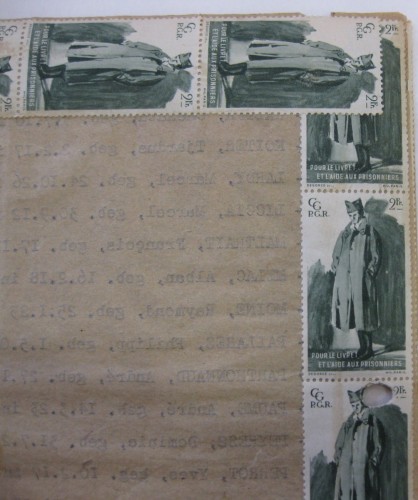Searching for the Dutch-Paris Escape Line
I’ve had many occasions over the last two weeks to remember what my friend at the Dutch Red Cross Archives pointed out: an archive preserves the idiosyncratic organization created by the person or institution that wrote the documents in it. An archive is not a library, where the books are arranged according to universally recognized categories. Furthermore, those original authors wrote the documents for their own ends, not the researcher’s.
That was all too apparent last week at the French military justice archives in Le Blanc (SHD, Le Blanc). Appropriately, these records are protected by several defensive rings. First one needs express, written permission to see any particular document held there. Then one needs to get there by car because they are kept far from public transport. In a military installation, behind a high wall topped with barbed wire. One surrenders one’s passport at the gate.
Once inside the bleakly bureaucratic building, however, the Colonel and his Adjoint could not be more gracious. But there was nothing they could do about the slender nature of the dossier I’d gone to such lengths to see. I was looking for the French interrogation reports of a German officer held in their custody after the war. But the German in question had not been tried by the French military tribunal on the technicality that he was paid by the Abwehr rather than the Gestapo. The court did not preserve any of the investigation into his activities because as far as the court was concerned, they weren’t necessary.
I had better luck at the Defense archives in Caen (SHD, Caen), which houses the papers of the Bureau of Former Victims of Contemporary Conflicts (BAVCC), which used to rule on whether an individual had the right to the title of “Deportee of the Resistance” or “Political Deportee” and such like, which had significant bearing on pensions, etc. The archive has a spiffy new reading room but hasn’t quite finished cataloging all the dossiers up in the attic. My thanks to Pascal Hureau for ferreting through the cabinets for so many relevant files for me.
Of course, he could only find something if the resister in question or his or her family had caused the original administration to open a file on that person. It would be hard to forget that most of these papers were written by civil servants of the Ministry of Prisoners of War, Deportees and Refugees because many of them had POW stamps lining or framing the back.

Vichy POW stamps
I asked Monsieur Hureau about this unusual embellishment to government documents. He explained that during the war the Vichy Ministry of Prisoners of War and Refugees (PGR in French) had sold these stamps to raise money for the more than one million French POWs captive in Germany. After the war, when they’d become de Gaulle’s Ministry for Prisoners of War, Deportees and Refugees (PGDR in French), they still had an important stock of stamps, but no scotch tape. So they used the stamps to reinforce the wartime paper.
It’s a good reminder of the material roots of all history, and of the archives from which it’s pieced back together.
- Tags: France


Leave a reply